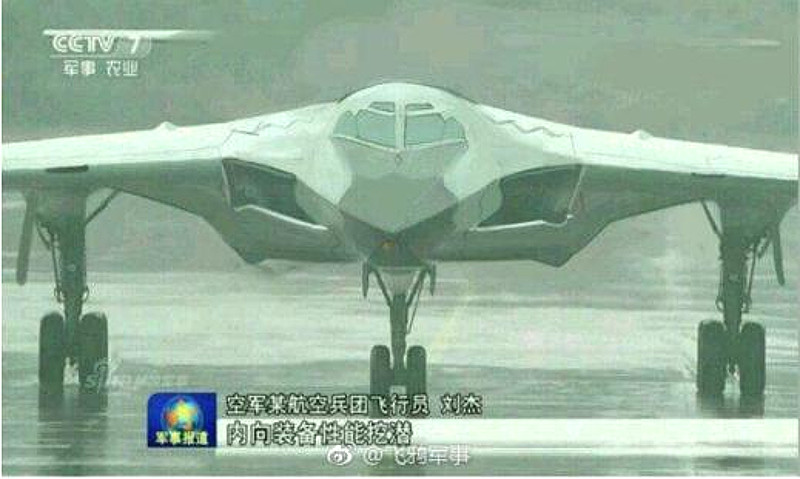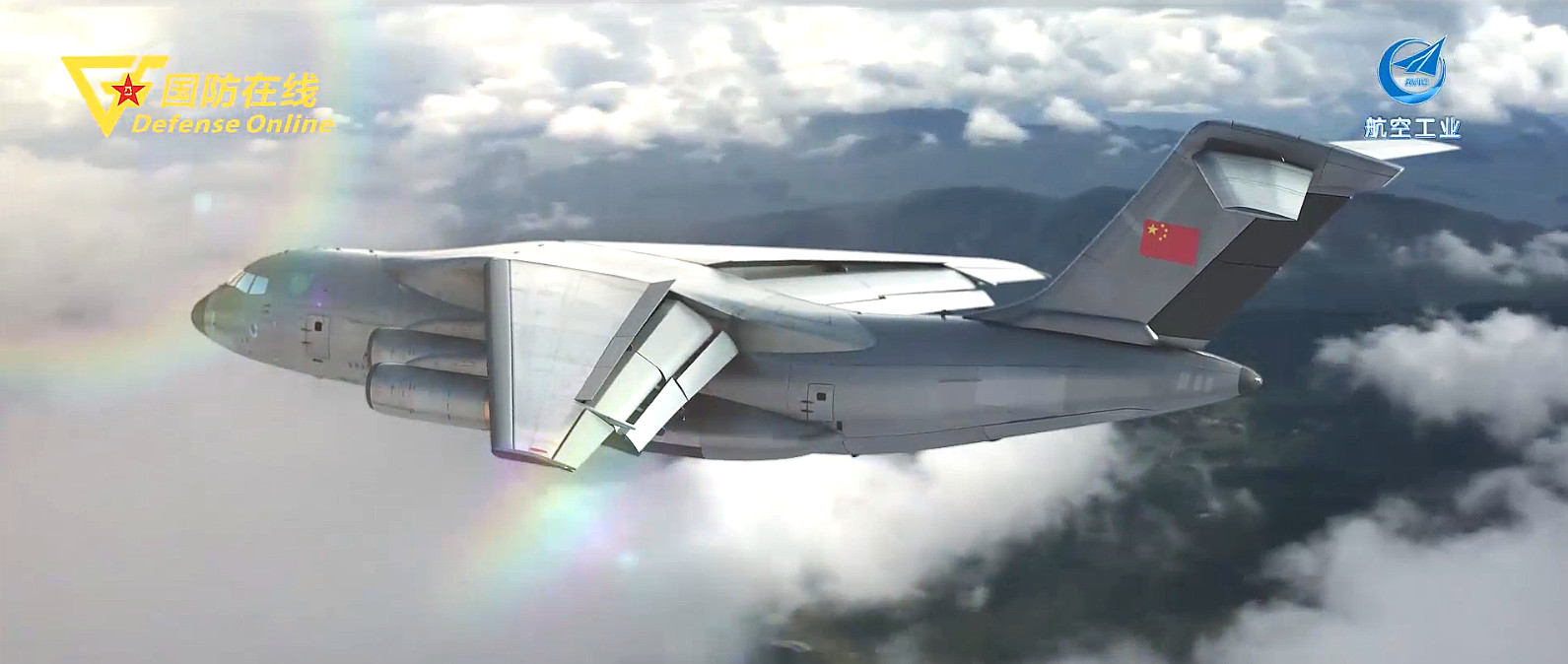The state-run Aviation Industry Corporation of China, or AVIC, may have given a first look at the long-rumored H-20 stealth bomber in a promotional video that apes Northrop Grumman’s famous Superbowl ad teasing what is now known as the B-21 Raider. The clip, which highlights the consortium’s various civil and military products, as well as those from its subsidiaries, has a number of other significant nods to the country’s strategic aviation capabilities, past and present.
China Defense Online posted a copy of the video, which combines file footage with slick computer-generated graphics, online on May 8, 2018. Though the presentation has AVIC branding only, it is specifically a celebration of the 60th anniversary of the founding of the Xi’an Aircraft Industrial Corporation, or XAC, which the Chinese government founded in 1958. XAC is reportedly responsible for the development of the H-20 and is also the primary firm behind the Y-20 airlifter, the country’s largest domestically designed aircraft.
Now, it’s important to note that AVIC is no stranger to putting together lavish video presentations to mark major anniversaries in Chinese military aviation. But hidden at the very end of the just over five-minute long video is the brief view of what appears to be a flying-wing style aircraft under a sheet with the text “The Next…” in English. The clip never specifically mentions the H-20 and doesn’t give any details about the aircraft, but it seems very likely that this was at least meant to represent the ongoing project.
This is exactly how Northrop Grumman teased the B-21 on national television in the United States during Superbowl XLIX in2015. To date, there have been no official pictures of the Raider and only very limited concept art of that aircraft.
Below is the Northrop Grumman commercial, which first aired during the Super Bowl in 2015.

Some have even suggested that the two clips are so close that the Chinese one may, in fact, be a heavily edited rip-off of Northrop Grumman’s ad itself and not part of the official AVIC video at all. It is definitely possible that China Defense Online added its own teaser to the end.
However, a side-by-side comparison of the two clips shows that they are very distinct in many of the details. The timing is still slightly curious, though. The AVIC video began making the rounds shortly after James Drew, a reporter for Aviation Week, made a cryptic post on Twitter that many thought might lead to the first actual images of the B-21.

We now know that Drew’s teaser tweet was a prank and he actually ended up announcing that he will be joining Northrop Grumman Mission Systems as Manager of Global Media, but his Tweet had already set off a storm of speculation online. This included one post from a Chinese military forum that was clearly meant to troll the announcement with a screenshot of the apparent AVIC reveal.
Whatever the exact origins of the H-20 segment are, according to a basic machine translation of the short China Defense Online story accompanying the video, its title is “Great Power Takeoff.” The bomber would certainly fit that description and presenting it in this way is clearly designed to demonstrate that China is capable of matching its western competitors.
There have similarly been no confirmed photos or concept art at all of the H-20—though there are numerous fan-made renderings of what it might look like—despite XAC having reportedly been actively at work on the aircraft since the early 2000s. The 603rd Aircraft Design Institute is also linked to the project, which by most reliable accounts is crafting an aircraft broadly similar to Northrop Grumman’s B-2 Spirit stealth bomber.
According to Airforces Monthly, reliable reports suggest the H-20’s basic design was largely frozen by 2011 and that XAC has built a number of subscale models, likely for aerodynamic and radar cross section evaluations, among other testing activities. Publicly available information suggests that base requirements called for an aircraft capable of carrying at least 10 tons of weaponry to an unrefueled range of 5,000 miles.

Its primary armament would likely be the CJ-10K air-launched land attack cruise missile, also known as the KD-20, which can carry either a conventional or nuclear payload and reportedly has a range of more than 930 miles. China has also shown examples of what may be a variant of the subsonic CJ-10 with low-observable characteristics itself.
The combination of the H-20 with a stealthier weapon would significantly improve the survivability of both the launch platform and the likelihood of the weapon successfully reaching its target. Previous reports have pointed to a future Chinese doctrine of having bombers fly right to the edge of a potential opponent’s airspace – the most likely possible adversary being the United States – before launching a missile barrage.
The platform could serve as more than just a cruise missile truck, though. For regional conflicts, especially against potential opponents such as India, it could be important to be able to pierce through air defenses to conduct conventional strikes on various critical targets such as airfields, command and control sites, and critical air defense nodes. This could help clear the path for follow-on missions using non-stealthy aircraft during more sustained operations.
All of this together would represent a significant jump in capability for the Chinese, who presently rely on upgraded H-6 bombers, derived from the Soviet-era Tu-16 Badger. Though more capable than the original design and now able to carry a variety of increasingly long-range stand-off weapons, including potentially air-launched ballistic missiles, those aircraft simply cannot project power far from China’s borders. Future versions with aerial refueling capability will allow them to fly missions further into the Pacific region, but the already dated design will only become more vulnerable to enemy aircraft and air defenses as time goes on.
The video below shows China’s H-6Ks during a large-scale training exercise in 2015.

“A medium-range bomber can’t essentially fix the PLA air force’s shortcomings in terms of strategic strike and strategic deterrence,” China Daily, an official newspaper of the Chinese Communist Party, reported in 2015, citing Chinese defense technology magazine Aerospace Knowledge. “Thus the air force does need an intercontinental strategic bomber capable of penetrating an enemy’s air defenses.”
Beyond likely teasing the forthcoming H-20 aircraft, whatever it might look like in the end, “Great Power Takeoff” has a number of other details that also strongly indicate China’s desire to expand its strategic aviation capabilities. The video itself starts with the original H-6 bomber, which was the first Chinese military aircraft to drop a nuclear bomb at the Lop Nur test site in 1965. The clip includes archival video and a computerized rendering of that event.

At another point in the video, starting at 3:25 in the runtime, you see a trio of older H-6 bombers flying through poor weather before shooting up into the sky. They appear to burn up as if they are leaving the atmosphere, but instead their skin peels away revealing the improved H-6K.
These aircraft carry either stand-off land attack or anti-ship missiles under their wings and YJ-12 supersonic anti-ship missiles in their bomb bays. These latter weapons are the air-launched version of the anti-ship weapons China just reportedly installed on some of its man-made outposts in the South China Sea and represent a credible threat to opposing warships. The H-6K reportedly forms an important part of Chinese anti-access and area-denial capabilities in the region.

The video also ends with a much longer look at the Y-20 cargo aircraft that XAC has been working on since the mid-2000s. Visually similar to Boeing’s C-17 Globemaster III, this aircraft could eventually give the Chinese military all-new strategic airlift capabilities that would also improve its ability to rapidly project power at greater distances. At present, the design remains limited by the lack of suitably powerful domestically-produced high-bypass turbofan engines to power it.
But so significant is the Y-20 to the PLA’s plans, that XAC reportedly slowed the H-20 bomber program to refocus resources into the cargo plane. Only after work on the initial airlifter prototype wrapped up in late 2012 did the company return to the H-20 in earnest.

Whatever delays might have occurred with the H-20 program specifically, the country’s various state-run institutions and industrial enterprises have clearly been hard at work in the meantime on other advanced air combat technologies. These include other low observable military aircraft such as the J-20 fighter jet, to help reduce the gap in parity with the United States in particular. Just in the last 18 months, we have seen new imagery and information slip out concerning new stealth unmanned combat air vehicles and drone swarms, hypersonic and anti-satellite weapons, electromagnetic railguns, advanced sensors, and more.
Unveiling the H-20 would be clearly in line with this apparent push, not only to modernize the Chinese military, but to potentially surge ahead of regional and international competitors and their respective capabilities. We might not have to wait much longer before finally catching a real glimpse of the new bomber.
Contact the author: jtrevithickpr@gmail.com
